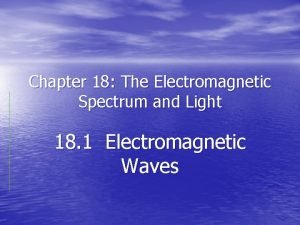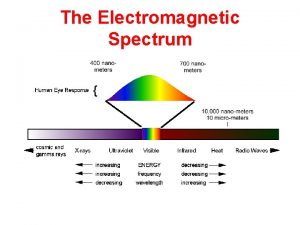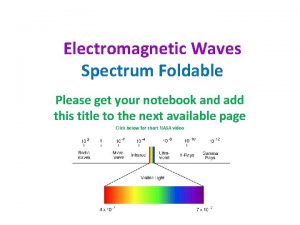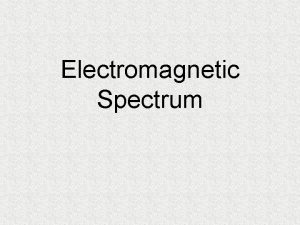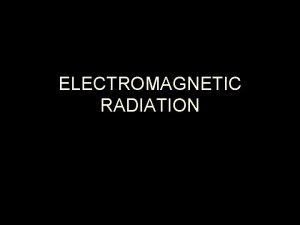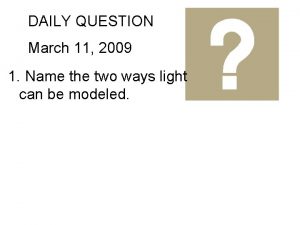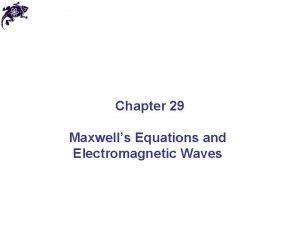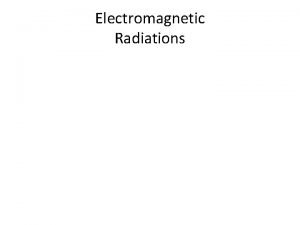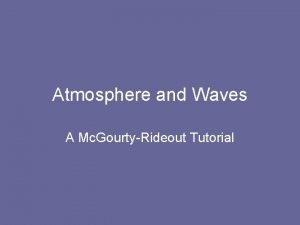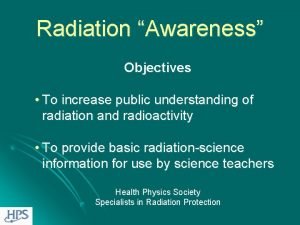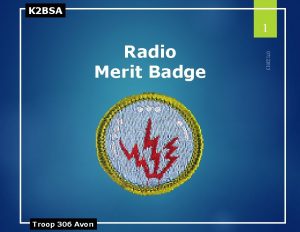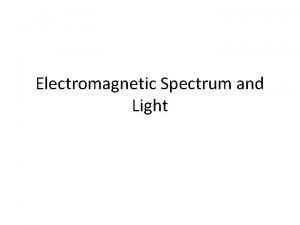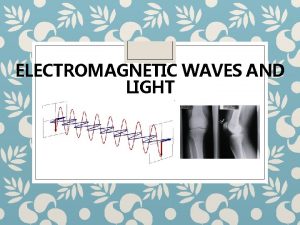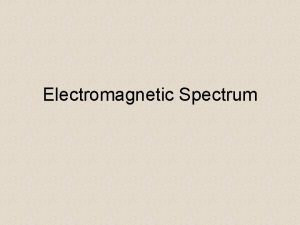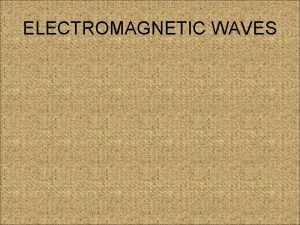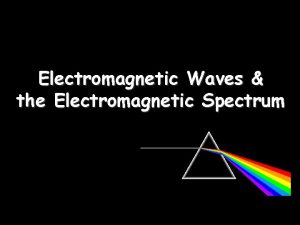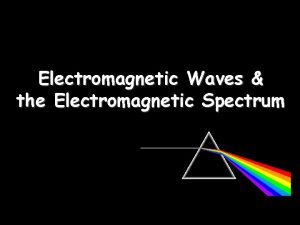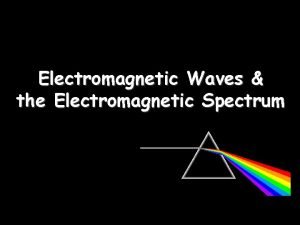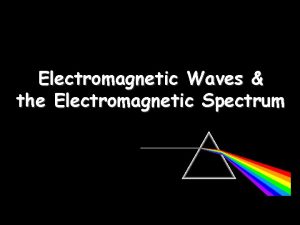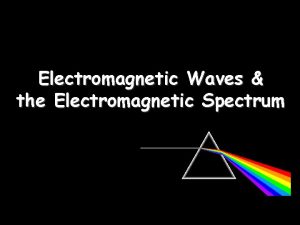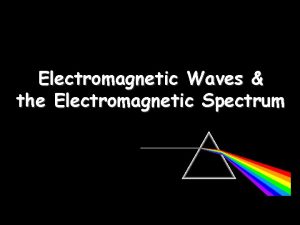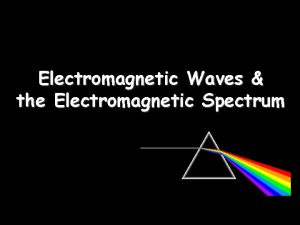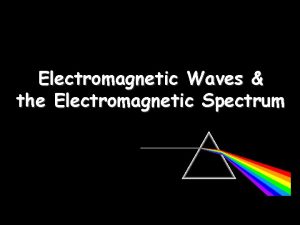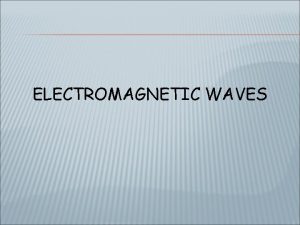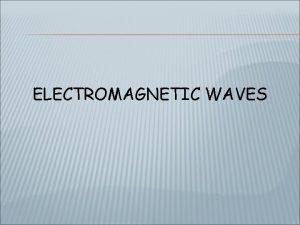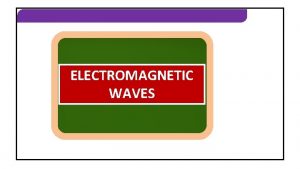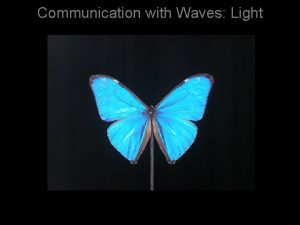Communication with Waves Light The electromagnetic spectrum Insects









![Attenuation by geometry: Inverse Square Law I = Q’/A Intensity [W/m 2] Q’ = Attenuation by geometry: Inverse Square Law I = Q’/A Intensity [W/m 2] Q’ =](https://slidetodoc.com/presentation_image_h/37ba809aa190d3cd41c747f26c2f3e47/image-10.jpg)




















- Slides: 30

Communication with Waves: Light

The electromagnetic spectrum = Insects & Birds Humans Snakes

In order to locate potential mates and other important natural resources in their environment, organisms must generate, transmit, receive and interpret relevant biological signals. Sender Receiver Environment

Many biological signals take the form of waves: SHM Phase velocity, Amplitude, Frequency, = Wavelength, I = 2

Signal sources Source 1) Self illumination: bioluminescence, molecular pigments 2) Indirect illumination or scattering: biological nanostructures 3) Active illumination

1) Self illumination: bioluminescence Angler fish Small squid Dinoflagellates http: //www. lifesci. ucsb. edu/~biolum

Miller et al. (2005) Detection of a bioluminescent milky sea from space. Proc. Nat. Acad. Sci. 102: 14181 -14184.

Signal generation: indirect illumination, scattering, reflection http: //astro. ensc-rennes. fr

Light interacts with matter in two fundamental ways: absorption and scattering Attenuation: reduction of a signal 1) Distance: Geometrical spreading & the conservation of energy 2) Scattering: reflecting or refracting off objects 3) Absorption
![Attenuation by geometry Inverse Square Law I QA Intensity Wm 2 Q Attenuation by geometry: Inverse Square Law I = Q’/A Intensity [W/m 2] Q’ =](https://slidetodoc.com/presentation_image_h/37ba809aa190d3cd41c747f26c2f3e47/image-10.jpg)
Attenuation by geometry: Inverse Square Law I = Q’/A Intensity [W/m 2] Q’ = A T 4 rearrange Radiation Power [W] Area [m 2] Q’ = I A Asphere = Temp. Stefan’s Constant [Wm-2 K-4] Emissivity [o 1] 4 r 2 Shiny Q’ = I 4 r 2 Black Q’ Energy is conserved Ia 4 ra 2 = Ib 4 rb 2 r a b 4 cancels Ia ra 2 = Ib rb 2 Intensity is inversely proportional to the square of the distance from the source I r -2

Inverse Square Law: simple example I = Q’/A I = Q’/ 4 r 2 I = 10 W / 4 r 2 Assume = 10 W

Attenuation by absorption and scattering: energy of wave partially lost I(x) = Io e- x Distance Intensity at distance x Source Intensity I Absorption coefficient x Attenuation depends on K Attenuation depends on Io - Sea water I Clear water Turbid water x

Most deep sea fish eyes have pigments that are sensitive to blue light

Many deep-sea organisms are red

Many deep-sea organisms generate blue light

Counter-illumination with blue light Bottom view Photophores

Active illumination: red biolumensense

Combined attenuation from geometrical spreading and absorption Step 1: find Io at surface of light organ Io = Q’/A Assume = 10 W r 2 Io =1 W / 0. 05 m 2 Deep-sea female angler fish Io =20 W m-2 Step 2: consider spreading & absorption I 2 = Io(ro 2/r 22)e- x = 0. 43 m-1 Spreading Absorption Assume = 0. 05 m 2 X = 0. 5 m ro = 0. 02 m I 2 = 20 Wm-2(0. 022 m/0. 52 m)e-(0. 43*0. 5) I 2 = 0. 26 Wm-2 [20% less than spreading alone]

Scattering: refraction and reflection blue - Light-scattering objects are randomly spaced - Phase relationships of the scattered waves are random - Color determined by the properties of scatterers (i. e. size) red - Smaller (blue) are preferentially scattered - Thin film interference - Scattering objects have order - Phases of scattered waves are non-random and therefore can constructively or destructively interfere with one another, Thereby increasing or decreasing intensity of wave field. - Colour is determined by the spatial distribution of lightscattering interfaces

Scattering: refraction and reflection - Examples of incoherent scattering include blue & red sky, blue ice and blue snow.

Coherent Scattering: iridescent butterfly scales Constructive interference occurs when nd = λ/4 for a single platelet. Light-scattering objects are arranged in laminar or crystal-like arrays. - Changes in the angle of observation or illumination affect the mean path length (2 d) of scattered waves - Such a change will affect the phase relationships among the scattered waves and change which wavelengths are constructively reinforced after scattering

Other than feathers, can birds also use coherent scattering to express colours on their skin that aren’t iridescent?

Coherent scattering from arrays of parallel collagen fibres in the dermis 2 D Fourier transform: characterize the spatial periodicity Ring indicates ordered structure

Ultraviolet, blue, green and yellow structural colours of avian skin are produced by coherent scattering (i. e. constructive interference), other colours employ pigmentary mechanisms in addition to structural order.

Butterfly scales also use coherent scattering

Refraction & Reflection - Light is fastest in a vacuum, in all other materials it is slower and therefore can change direction (Snell’s law) - Some energy is transmitted (refraction) and some is not (reflected). Fast medium - Total Internal Reflection occurs at the critical angle Slow medium

How do tissues become transparent?

Small bumps enhance transparency < 0. 5 Gradual transition of , therefore the index of refraction gradually changes: no reflection

Polarized Light electromagnetic wave & transverse electric field Depolarized light has radially symmetric transverse electric fields (i. e. direct sunlight) Filter selects one component from all of the different planes of light and lets that one component get through Polarized light (i. e. light scattered at 90 )

Light Habitats & Polarized Iridescence Complete Polarization Live in Open Habitats (sunlight is depolarized) Moderate Polarization Depolarized Live in Forest Habitats (polarized scattered light)
 Sound waves are longitudinal waves true or false
Sound waves are longitudinal waves true or false Electromagnetic spectrum chart
Electromagnetic spectrum chart Low amplitude wave
Low amplitude wave Mechanical waves characteristics
Mechanical waves characteristics Mechanical waves and electromagnetic waves similarities
Mechanical waves and electromagnetic waves similarities Difference between matter waves and electromagnetic waves
Difference between matter waves and electromagnetic waves Mechanical waves vs electromagnetic waves
Mechanical waves vs electromagnetic waves Similarities of mechanical and electromagnetic waves
Similarities of mechanical and electromagnetic waves Mechanical waves and electromagnetic waves venn diagram
Mechanical waves and electromagnetic waves venn diagram Chapter 18 the electromagnetic spectrum and light
Chapter 18 the electromagnetic spectrum and light Shortest to longest wavelength
Shortest to longest wavelength Waves are produced by stars and galaxies.
Waves are produced by stars and galaxies. Em waves song lyrics
Em waves song lyrics Electromagnetic spectrum foldable
Electromagnetic spectrum foldable Raging martians invade venus
Raging martians invade venus Electromagnetic spectrum micrometers
Electromagnetic spectrum micrometers Em spectrum mnemonic
Em spectrum mnemonic Electromagnetic spectrum foldable
Electromagnetic spectrum foldable Theory of james clerk maxwell
Theory of james clerk maxwell How do matter and energy interact when waves are generated
How do matter and energy interact when waves are generated The food
The food Types of radiation in the electromagnetic spectrum
Types of radiation in the electromagnetic spectrum What is the electromagnetic spectrum
What is the electromagnetic spectrum Electromagnetic spectrum
Electromagnetic spectrum Spectrum dmca
Spectrum dmca Electromagnetic spectrum
Electromagnetic spectrum Electromagnetic spectrum nasa
Electromagnetic spectrum nasa Wavelength of electromagnetic radiation formula
Wavelength of electromagnetic radiation formula Light has a dual nature
Light has a dual nature Electromagnetic spectrum
Electromagnetic spectrum Troop 306
Troop 306









